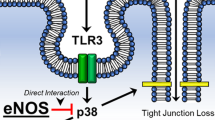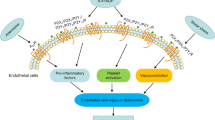Abstract
Background
CD39 is the dominant vascular nucleoside triphosphate diphosphohydrolase (NTPDase) that exerts major effects on platelet reactivity by the regulated hydrolysis of extracellular adenine nucleotides. The effects of NTPDases on endothelial cell (EC) activation and apoptosis remain unexplored.
Material and Methods
Recombinant replication-deficient adenoviruses were constructed with human CD39 cDNA (rAdCD39) or the bacterial β-galactosidase (rAdβgal).
Results
Intact human umbilical vein EC cultures infected with rAdCD39 had substantial and stable increases in NTPDase biochemical activity (14.50 ± 3.50 Pi nmole/well/min), when contrasted with noninfected cells (0.95 ± 0.002) and rAdβgal infected cells (1.01 ± 0.02; p <0.005). Increased NTPDase activity efficiently inhibited immediate type 2Y purinergic receptor (P2Y)-mediated EC activation responses viz. von Willebrand factor secretion in response to extracellular ATP. In addition, CD39 up-regulation blocked ATP-induced translocation of the transcription nuclear factor (NF)-κB to the cell nucleus, and abrogated transcription of mRNA encoding E-selectin, and consequent protein synthesis. CD39 also decreased the extent of apoptosis triggered by putative type-2X purinergic (P2X7) receptors in response to high concentrations of extracellular ATP in vitro.
Conclusion
These properties of CD39 indicate primary vascular protective effects with potential therapeutic applications.





Similar content being viewed by others
References
Kittel A, Kaczmarek E, Sevigny J, Lengyel K, Csizmadia E, Robson SC. (1999) CD39 as a caveolar-associated ectonucleotidase. Biochem. Biophys. Res. Comm. 262: 596–599.
Kaczmarek E, Koziak K, Sevigny J, et al. (1996) Identification and characterization of CD39 vascular ATP diphosphohydrolase. J. Biol. Chem. 271: 33116–33122.
Marcus AJ, Broekman MJ, Drosopoulos JHF, et al. (1997) The endothelial cell ecto-ADPase responsible for inhibition of platelet function is CD39. J. Clin. Invest. 99: 1351–1360.
Koziak E, Sevigny J, Robson SC, Siegel JB, Kaczmarek K. (1999) Analysis of CD39/ATP diphosphohydrolase expression in endothelial cells, platelets and leukocytes. Thromb. Haemost. 82: 1538–1544.
Zimmermann H. (1999) Two novel families of ectonucleotidases: molecular structure, catalytic properties and a search for function. TIPS 20: 231–236.
Zimmermann H. (1992) 5′-nucleotidase: molecular structure and functional aspects. Biochem. J. 285: 345–365.
Abbracchio MP, Burnstock G. (1994) Purinoceptors—are there families of P2X and P2Y purinoceptors [Review]. Pharmacol. Therap. 64: 445–475.
Cronstein BN, Bouma MG, Becker BF. (1996) Purinergic mechanisms in inflammation. Drug Develop. Res. 39: 426–435.
Barros LF, Yudilevich DL, Jarvis SM, Beaumont N, Young JD, Baldwin SA. (1995) Immunolocalisation of nucleoside transporters in human placental trophoblast and endothelial cells: evidence for multiple transporter isoforms. Pflugers. Archiv. Eur. J. Physiol. 429: 394–399.
Coade SB, Pearson JD. (1989) Metabolism of adenine nucleotides in human blood. Circ. Res. 65: 531–537.
Luthje J. (1989) Origin, metabolism and function of extracellular adenine nucleotides in the blood [published erratum appears in J. Klin. Wochenschr. (1989) 67: 558]. [Review]. J. Klin. Wochenschr. 67: 317–327.
Motte S, Communi D, Pirotton S, Boeynaems JM. (1995) Involvement of multiple receptors in the actions of extracellular ATP: the example of vascular endothelial cells. [Review]. Int. J. Biochem. Cell Biol. 27: 1–7.
Vischer UM, Wolheim CB. (1998) Purine nucleotides induce regulated secretion of von Willebrand factor. Blood. 91: 118–127.
Cotran RS, Pober, J. S. (1990) Cytokine-endothelial interactions in inflammation, immunity, and vascular injury. J. Amer. Soc. Nephrol. 1: 225–235.
Cotran RS, Pober JS. (1989) Effects of cytokines on vascular endothelium: their role in vascular and immune injury. Kidney Int. 35: 969–975.
Pober JS, Cotran RS. (1990) Cytokines and endothelial cell biology. Physiol. Rev. 70: 427–451.
Bach FH, Robson SC, Ferran C, et al. (1994) Endothelial cell activation and thromboregulation during xenograft rejection [Review]. Immunol. Rev. 141: 5–30.
Siebenlist U, Franzoso G, and Brown K. (1994) Structure, regulation and function of NF-κB. Annu. Rev. Cell Biol. 10: 405–455.
Baeuerle PA, Henkel T. (1994) Function and activation of NF-κB in the immune system. Ann. Rev. Immunol. 12: 141–179.
Von Albertini M, Palmetshofer A, Kaczmarek E, et al. (1998) Extracellular ATP and ADP activate transcription factor NF-κ-b and induce endothelial cell apoptosis. Biochem. Biophys. Res. Comm. 248: 822–829.
Ferrari D, Wesselborg S, Bauer M, Schulze OK. (1997) Extracellular ATP activates transcription factor NF-κB through the P2Z purinoreceptor by selectively targeting NF-κB p65. J. Cell. Biol. 139: 1635–1643.
Franceschi C, Abbracchio MP, Barbieri D, et al. (1996) Purines and cell death. Drug Develop. Res. 39: 442–449.
Marcus AJ, Safier LB, Hajjar KA, Ullman HL, Islam N, Broekman MJ, Eiroa AM. (1991) Inhibition of platelet function by an aspirin-insensitive endothelial cell ADPase. Thromboregulation by endothelial cells. J. Clin. Invest. 88: 1690–1696.
Marcus AJ, Safier LB. (1993) Thromboregulation: multicellular modulation of platelet reactivity in hemostasis and thrombosis. [Review]. FASEB J. 7: 516–522.
Robson SC, Kaczmarek E, Siegel JB, et al. (1997) Loss of ATP diphosphohydrolase activity with endothelial cell activation. J. Exp. Med. 185: 153–163.
Enjyoji K, Sevigny J, Lin Y, et al. (1999) Targeted disruption of cd39/ATP diphosphohydrolase results in disordered hemostasis and thromboregulation. Nature Med. 5: 1010–1017.
Fabre JF, Nguyen M, Latour A, et al. (1999) Decreased platelet aggregation, increased bleeding time and resistance to thromboembolism in P2Y1-deficient mice. Nature Med. 5: 1199–1202.
Deguchi H, Takeya H, Urano H, Gabazza EC, Zhou H, Suzuki K. (1998) Adenosine regulates tissue factor expression on endothelial cells. Thrombosis Res. 91: 57–64.
Robson SC, Candinas D, Siegel JB, et al. (1996) Potential mechanism of abnormal thromboregulation in xenograft rejection—loss of ecto-ATPases upon endothelial cell activation. Transplantation Proc. 28: 536.
Candinas D, Koyamada N, Miyatake T, et al. (1996) Loss of rat glomerular ATP diphosphohydrolase activity during reperfusion injury is associated with oxidative stress reactions. Thromb. Haemost. 76: 807–812.
Robson SC, Daoud S, Begin M, et al. (1997) Modulation of vascular ATP diphosphohydrolase by fatty acids. Blood Coagul. Fibrinolysis 8: 21–27.
Robson SC, Candinas D, Hancock WW, Wrighton C, Winkler H, Bach FH. (1995) Role of endothelial cells in transplantation. [Review]. Int.Arch. Allergy Immunol. 106: 305–322.
Bach FH, Winkler H, Ferran C, Hancock WW, Robson SC. (1996) Delayed xenograft rejection [Review]. Immunol. Today 17: 379–384.
Koyamada N, Miyatake T, Candinas D, et al. (1996) Apyrase administration prolongs discordant xenograft survival. Transplantation 62: 1739–1743.
Soares MP, Muniappan A, Kaczmarek E, et al. (1998) Adenovirus-mediated expression of a dominant negative mutant of P65/RelA inhibits proinflammatory gene expression in endothelial cells without sensitizing to apoptosis. J. Immunol. 161: 4572–4582.
Baykov AA, Evtushenko OA, Avaeva SM. (1988) A malachite green procedure for orthophosphate determination and its use in alkaline phosphatase-based enzyme immunoassay. Analyt. Biochem. 171: 266–270.
Winkler H, Stuhlmeier K, Cheng Q, Csizmadia V, Bach FH. (1994) Inhibition of E-selectin transcription by an α-globulin. J. Cell. Biochem. 18A: 325.
Boeynaems J-M, Pearson JD. (1990) P2 purinoreceptors on vascular endothelial cells: physiological significance and transduction mechanisms. TIPS 11: 34–37.
Dubyak GR, Elmoatassim C. (1993) Signal transduction via P2-purinergic receptors for extracellular ATP and other nucleotides [Review]. Am. J. Physiol. 265: C577–C606.
Brake A, Schumacher M, Julius D. (1996) ATP receptors in sickness, pain and death. Chem. Biol. 3: 229–232.
Hechler B, Leon C, Vial C, et al. (1998) The P2y(1) receptor is necessary for adenosine 5′-diphosphate-induced platelet aggregation. Blood 92: 152–159.
Jin JG, Kunapuli SP. (1998) Coactivation of two different G protein-coupled receptors is essential for ADP-induced platelet aggregation. Proc. Nat. Acad. Sci. USA 95: 8070–8074.
Sun B, Li J, Okahara K, Kambayashi J. (1998) P2x(1) Purinoceptor in human platelets—molecular cloning and functional characterization after heterologous expression. J. Biol. Chem. 273: 11544–11547.
Daniel JL, Dangelmaier C, Jin JG, Ashby B, Smith JB, Kunapuli SP. (1998) Molecular basis for ADP-induced platelet activation I—evidence for three distinct ADP receptors on human platelets. J. Biol. Chem. 273: 2024–2029.
Jin JG, Daniel JL, Kunapuli SP. (1998) Molecular basis for ADP-induced platelet activation — the P2y1 receptor mediates ADP-induced intracellular calcium mobilization and shape change in platelets. J. Biol. Chem. 273: 2030–2034.
Yang S, Cheek DJ, Westfall DP, Buxton IL. (1994) Purinergic axis in cardiac blood vessels. Agonist-mediated release of ATP from cardiac endothelial cells. Circ. Res. 74: 401–407.
Fisette PL, Denlinger LC, Proctor RA, Bertics PJ. (1996) Modulation of macrophage function by P2Y-purinergic receptors [Review]. Drug Develop. Res. 39: 377–387.
Juul B, Plesner L, Aalkjaer C. (1993) Effects of ATP and related nucleotides on the tone of isolated rat mesenteric resistance arteries. J. Pharmacol. Exp. Therap. 264: 1234–1240.
Chow SC, Kass G, Orrenius S. (1997) Purines and their roles in apoptosis. Neuropharmacology 36: 1149–1156.
Ferrari D, Chiozzi P, Falzoni S, et al. (1997) ATP-mediated cytotoxicity in microglial cells. Neuropharmacology 36: 1295–1301.
Chadwick BP, Frischauf AM. (1997) Cloning and mapping of a human and mouse gene with homology to ecto-ATPase genes. Mammal. Gen. 8: 668–672.
Shaul PW, Anderson RGW. (1998) Role of plasmalemmal caveolae in signal transduction [Review]. Amer. J. Physiol. — Lung Cell. Mol. Physiol. 19: L843–L851.
Esch JSA, Sevigny J, Kaczmarek E, et al. (1999) Structural elements and limited proteolysis of CD39 influence ATP diphosphohydrolase activity. Biochemistry. 38: 2248–2258.
Cotran RS, Pober JS. (1989) Endothelial activation and inflammation. Prog. Immunol. 8: 747.
Ferrari D, Chiozzi P, Falzoni S, Hanau S, Divirgilio F. (1997) Purinergic modulation of interleukin-1-β release from microglial cells stimulated with bacterial endotoxin. J. Exp. Med. 185: 579–582.
Griffiths RJ, Stam EJ, Downs JT, Otterness IG. (1995) ATP induces the release of IL-1 from LPS-primed cells in vivo. J. Immunol. 154: 2821–2828.
Bombeli T, Karsan A, Tait JF, Harlan JM. (1997) Apoptotic vascular endothelial cells become procoagulant. Blood 89: 2429–2442.
Bombeli T, Schwartz BR, Harlan JM. (1999) Endothelial cells undergoing apoptosis become proadhesive for nonactivated platelets. Blood 93: 3831–3838.
Nicholson DW, Thornberry NA. (1997) Caspases—killer proteases [Review]. TIPS 22: 299–306.
Imai M, Takigami K, Guckelberger O, et al. (In press) Recombinant adenoviral mediated CD39 gene transfer prolongs cardiac xenograft survival. Transplantation August, 2000 in press.
Candinas D, Lesnikoski BA, Hancock WW, et al. (1996) Inhibition of platelet integrin GPIIbIIIa prolongs survival of discordant cardiac xenografts. Transplantation 62: 1–5.
Traut TW. (1994) Physiological concentrations of purines and pyrimidines [Review]. Mol. Cell. Bioch. 140: 1–22.
Gayle RB, Maliszewski CR, Gimpel SD, et al. (1998) Inhibition of platelet function by recombinant soluble ecto-ATPase/CD39. J. Clin. Invest. 101: 1851–1859.
Wang TF, Ou Y, Guidotti G. (1998) The transmembrane domains of ectoapyrase (CD39) affect its enzymatic activity and quaternary structure. J. Biol. Chem. 273: 24814–24821.
Wang TF, Handa M, Guidotti G. (1998) Structure and function of ectoapyrase (CD39). Drug Develop. Res. 45: 245–252.
Matsumoto M, Sakurai Y, Kokubo T, et al. (1999) The cDNA cloning of human placental ecto-ATP diphosphohydrolases I and II. FEBS Letters 453: 335–340.
Acknowledgments
CG is a recipient of a fellowship from the Deutsche Forschungsgemeinschaft. This work was supported by NIH R01 HL57307 and American Heart Association Grant in Aid 9650490N. SCR also thanks the MRC UCT Liver Center, Cape Town, South Africa for early research support that facilitated the current work.
Author information
Authors and Affiliations
Corresponding author
Rights and permissions
About this article
Cite this article
Goepfert, C., Imai, M., Brouard, S. et al. CD39 Modulates Endothelial Cell Activation and Apoptosis. Mol Med 6, 591–603 (2000). https://doi.org/10.1007/BF03401797
Accepted:
Published:
Issue Date:
DOI: https://doi.org/10.1007/BF03401797




